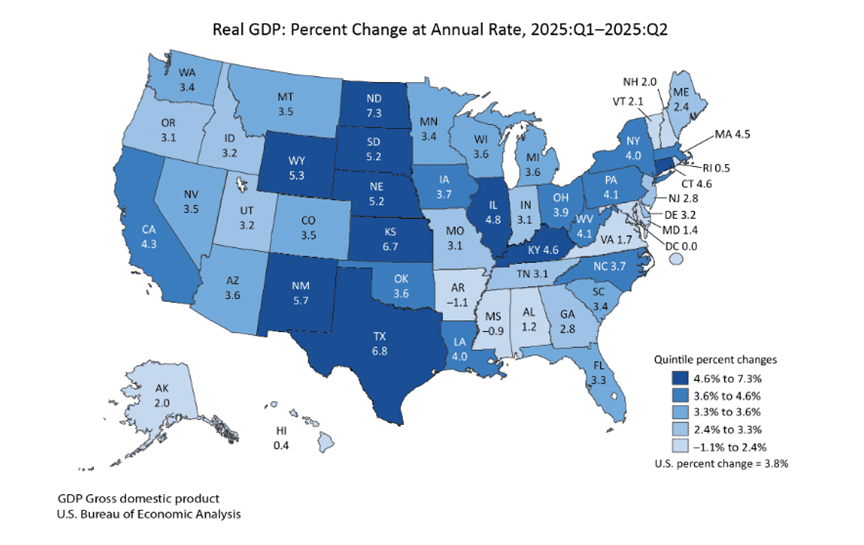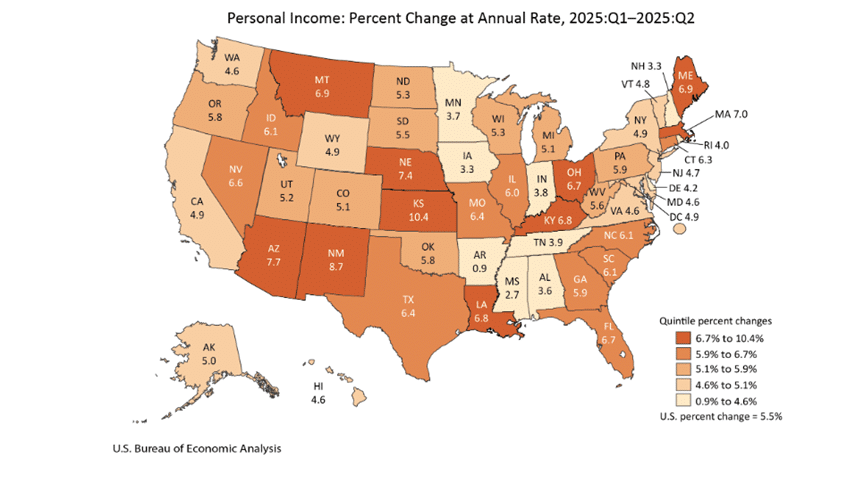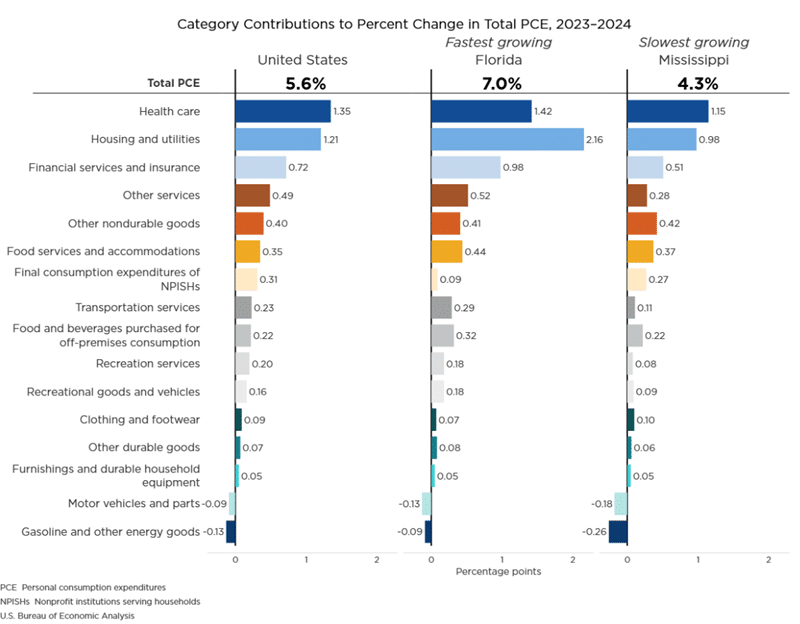The US Bureau of Economic Analysis reported that in the second quarter of 2025, real GDP grew in 48 states, led by industries like finance, insurance, and mining. Personal income increased across all states, driven by earnings, transfer payments, and property income. In 2024, personal consumption expenditures rose nationwide, with health care and housing as the biggest contributors. Despite overall growth, some states saw declines in specific sectors like energy and manufacturing. They write:
Today, the U.S. Bureau of Economic Analysis released new quarterly statistics on gross domestic product and personal income for all 50 states and the District of Columbia for the second quarter of 2025 (April, May, and June), along with new annual statistics on state personal consumption expenditures for 2024.
Gross domestic product (GDP) highlights
Real GDP increased in 48 states in the second quarter of 2025. The percent change at an annual rate in real GDP was 3.8 percent nationally, with state-level changes ranging from a 7.3 percent increase in North Dakota to a 1.1 percent decline in Arkansas. In the District of Columbia, real GDP growth was unchanged.
In the second quarter of 2025, real GDP increased in 15 of the 23 industry groups for which BEA prepares quarterly state estimates. Finance and insurance, information, and nondurable-goods manufacturing were the leading contributors to growth in real GDP nationally. These industries were also the leading contributors to real GDP growth in half the states. Two other industries that impacted real GDP growth in several states were agriculture, forestry, fishing, and hunting and mining, quarrying, and oil and gas extraction.
- Mining, quarrying, and oil and gas extraction increased in 45 states and was the leading contributor to growth in eight states including North Dakota, Texas, New Mexico, and Wyoming, the states with the first-, second-, fourth-, and fifth-largest increases in real GDP, respectively.
- Agriculture, forestry, fishing, and hunting increased in 27 states and was the leading contributor to growth in six states including Kansas, the state with the third-largest increase in real GDP. In contrast, this industry was the leading offset to growth in six states including Arkansas and Mississippi, the two states where real GDP declined.
Personal income highlights
Personal income increased in all 50 states and the District of Columbia in the second quarter of 2025. The percent change at an annual rate in current-dollar personal income was 5.5 percent nationally, with state-level changes ranging from a 10.4 percent increase in Kansas to a 0.9 percent increase in Arkansas. In the District of Columbia, personal income increased by 4.9 percent.
In the second quarter of 2025, all components of personal income—earnings, transfer receipts, and property income (dividends, interest, and rent)—contributed to the increase in personal income nationally. Each component increased in all 50 states and the District of Columbia except for earnings, which declined in Arkansas and Mississippi.
- Earnings increased 4.4 percent nationally, with state-level changes in earnings ranging from a 12.2 percent increase in Kansas to a 3.3 percent decrease in Arkansas. Earnings was the largest contributor to growth in personal income in 21 states and the District of Columbia.
- Transfer receipts increased 14.4 percent nationally, with state-level changes in transfer receipts ranging from a 23.8 percent increase in Massachusetts to a 5.5 percent increase in Tennessee. Transfer receipts was the largest contributor to growth in personal income in 29 states. The increase in transfer receipts was due in part to retroactive payments to Social Security beneficiaries under the Social Security Fairness Act of 2024.
- Property income increased 1.0 percent nationally, with state-level changes in property income ranging from a 1.4 percent increase in Wyoming to a 0.8 percent increase in Kansas, Illinois, Alaska, Iowa, and Louisiana.
Personal consumption expenditures (PCE) highlights
PCE increased in all 50 states and the District of Columbia in 2024. Current-dollar PCE increased 5.6 percent nationally, with state-level changes in PCE ranging from a 7.0 percent increase in Florida to a 4.3 percent increase in Mississippi. In the District of Columbia, PCE increased 6.6 percent.
In 2024, PCE increased in 14 of the 16 major categories for which BEA prepares estimates. Health care and housing and utilities were the largest contributors to the increase in PCE nationally. They were also the leading contributors to PCE growth in 49 states. PCE decreased in two categories, gasoline and other energy goods and motor vehicles and parts. These two categories were the largest subtractions to growth in 49 states and the District of Columbia.
- Health care increased 8.3 percent nationally and was the largest contributor to state PCE growth in 34 states.
- Housing and utilities increased 6.8 percent nationally and was the largest contributor to growth in 15 states including Florida, the state with the largest increase in PCE, and the District of Columbia.
- Gasoline and other energy goods decreased 5.2 percent nationally and was the largest subtraction to growth in 37 states including Mississippi, the state with the smallest increase in PCE.









